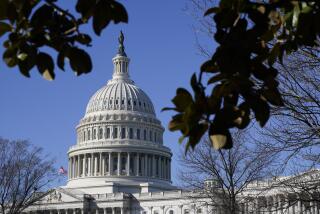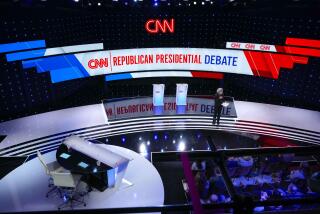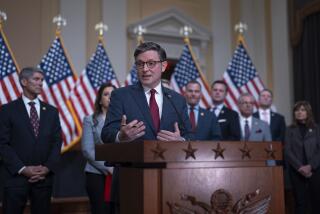In battle for House, party committees still shaping strategy
Independent groups continue to make their final push Thursday in the battle for the House, with both right- and left-leaning groups announcing millions more in advertising spending for the last 12 days of the campaign.
But as the outside cash rolls in to the 50 or so competitive House races across the country, it’s worth keeping in mind that “super PACs” and their nonprofit brethren are just one piece of the advertising puzzle. The official party committees play a crucial role in shaping the battle for the airwaves.
The campaign arms of both the House Democrats and Republicans laid down their markers as early as last spring and summer, reserving time in the media markets where they anticipated hot races.
There’s an economic benefit to making the early commitments.
INTERACTIVE: Outside spending in congressional races
“Airtime is like airline tickets,” said Robby Mook, executive director of the Democratic Congressional Campaign Committee. “If you lock in early, you get better rates.”
Those reservations also served as a road map for the outside groups, as they chose where to strike. The outside groups cannot coordinate spending or strategy with the party committees. But by relying on intelligence from their media buyers, the nonparty players could see where and when the party committees planned to go on the air and book their time accordingly. The result: a tightly choreographed spending relay, with outside groups taking the lead when the party committees went dark.
“Before making any decisions we look closely at how competitive the landscape is and what groups are spending in what races,” said Andy Stone, communications director for the House Majority PAC, a Democratic super PAC. His group rolled out $1 million in ads Thursday, part of a $4.1-million push this week.
The DCCC and its GOP counterpart, the National Republican Congressional Committee, spent about the same on their reservations: $61 million in time reserved by the Democrats compared with $57 million reserved by the Republicans, according to sources on both sides who are tracking ad buys.
But the NRCC chose to spend the bulk of its resources early -- $41 million spent between July 15 and Oct. 18.
INTERACTIVE: Battleground states map
“We consider it our responsibility to define Democrats early and often,” said Andrea Bozek, an NRCC spokeswoman. “That’s been our strategy from the beginning, and it’s a big reason why many of our Democrat targets are in an unwinnable position with less than two weeks to go.”
Republican outside groups are happy to take the spending lead for the final push.
“The NRCC’s strong fundraising gave them the resources to spend big in both September and October, allowing groups like ours to hold much of our fire for reaching undecided voters in the critical month of October,” said Dan Conston, a spokesman for American Action Network, a nonprofit group, and its super PAC affiliate, the Congressional Leadership Fund.
Those groups announced Thursday that they were upping their October ad budget by $4.7 million. They are now on track to spend $18.2 million this month.
The DCCC, on the other hand, spent $21 million on ads between July 15 and Oct. 15, about a third of its media reservation. It was an inverse approach to the Democratic outside groups, who opted to spend most of their resources in the early months of the race. Democrats still expect to be outgunned by Republican outside groups, but they hope the existence of a coordinated outside network of their own could narrow the spending gap.
But the party says it has another answer to Republican outside spending: the Democratic candidates.
A central part of the DCCC strategy this cycle is taking advantage of laws that say federal candidates must get the lowest unit rate for advertising time. Other political advertisers, including the party committees and the outside groups, are at the mercy of an increasingly competitive market where inventory is tight and prices are climbing. In some cases, the differential between the rate for candidates and the rate for outside groups is hundreds of dollars.
INTERACTIVE: Campaign contributions, by state
“We know we can’t outspend them,” said the DCCC’s Mook. “But if a candidate gets a dollar, it’s going to be worth two or three times as much as a super PAC dollar.”
The DCCC has raised $7.2 million directly for candidates this cycle, while the NRCC has raised around $600,000. Both parties have also invested in ads coordinated with individual campaigns, which are also eligible for the lower rate.
Between June 1 and Oct. 21, Democratic candidates have run nearly 134,000 ads on their own or in coordination with the DCCC, according to data from the ad tracking firm Kantar Media/CMAG analyzed by the Wesleyan Media Project. Republicans, meanwhile, ran about 123,000 candidate and coordinated ads.
In all, ads that were subject to the lowest unit rate accounted for about 69% of all Democratic House ads that ran between June 1 to Oct. 21, and 61% of all Republican House ads.
The benefits of the lowest unit rate extend beyond House races. In a report issued Wednesday, the Wesleyan Media Project noted that between Oct. 1 and Oct. 21, President Obama’s campaign and allies had run about 15,000 more ads than the Romney campaign and his outside supporters, while spending nearly $10 million less than the pro-Romney forces.
Follow Politics Now on Twitter and Facebook
Twitter: @melmason
More to Read
Get the L.A. Times Politics newsletter
Deeply reported insights into legislation, politics and policy from Sacramento, Washington and beyond. In your inbox three times per week.
You may occasionally receive promotional content from the Los Angeles Times.







